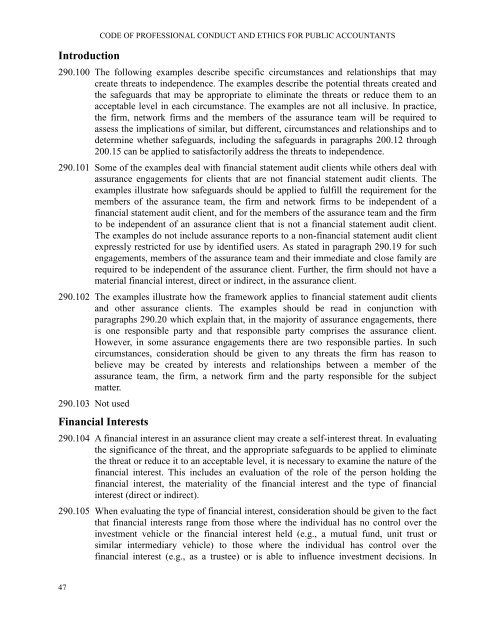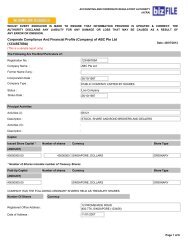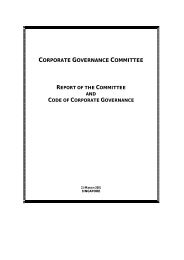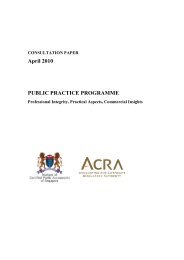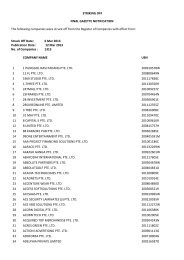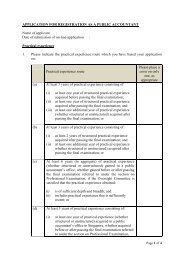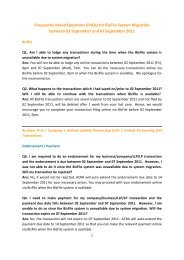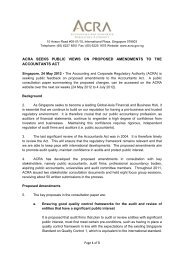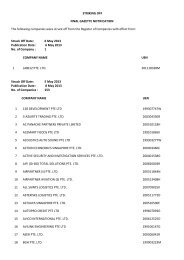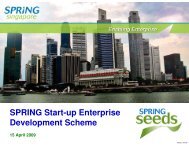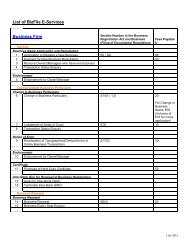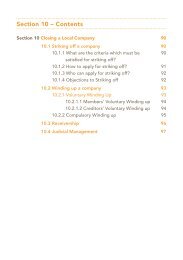Exposure Draft - ACRA
Exposure Draft - ACRA
Exposure Draft - ACRA
Create successful ePaper yourself
Turn your PDF publications into a flip-book with our unique Google optimized e-Paper software.
Introduction<br />
CODE OF PROFESSIONAL CONDUCT AND ETHICS FOR PUBLIC ACCOUNTANTS<br />
290.100 The following examples describe specific circumstances and relationships that may<br />
create threats to independence. The examples describe the potential threats created and<br />
the safeguards that may be appropriate to eliminate the threats or reduce them to an<br />
acceptable level in each circumstance. The examples are not all inclusive. In practice,<br />
the firm, network firms and the members of the assurance team will be required to<br />
assess the implications of similar, but different, circumstances and relationships and to<br />
determine whether safeguards, including the safeguards in paragraphs 200.12 through<br />
200.15 can be applied to satisfactorily address the threats to independence.<br />
290.101 Some of the examples deal with financial statement audit clients while others deal with<br />
assurance engagements for clients that are not financial statement audit clients. The<br />
examples illustrate how safeguards should be applied to fulfill the requirement for the<br />
members of the assurance team, the firm and network firms to be independent of a<br />
financial statement audit client, and for the members of the assurance team and the firm<br />
to be independent of an assurance client that is not a financial statement audit client.<br />
The examples do not include assurance reports to a non-financial statement audit client<br />
expressly restricted for use by identified users. As stated in paragraph 290.19 for such<br />
engagements, members of the assurance team and their immediate and close family are<br />
required to be independent of the assurance client. Further, the firm should not have a<br />
material financial interest, direct or indirect, in the assurance client.<br />
290.102 The examples illustrate how the framework applies to financial statement audit clients<br />
and other assurance clients. The examples should be read in conjunction with<br />
paragraphs 290.20 which explain that, in the majority of assurance engagements, there<br />
is one responsible party and that responsible party comprises the assurance client.<br />
However, in some assurance engagements there are two responsible parties. In such<br />
circumstances, consideration should be given to any threats the firm has reason to<br />
believe may be created by interests and relationships between a member of the<br />
assurance team, the firm, a network firm and the party responsible for the subject<br />
matter.<br />
290.103 Not used<br />
Financial Interests<br />
290.104 A financial interest in an assurance client may create a self-interest threat. In evaluating<br />
the significance of the threat, and the appropriate safeguards to be applied to eliminate<br />
the threat or reduce it to an acceptable level, it is necessary to examine the nature of the<br />
financial interest. This includes an evaluation of the role of the person holding the<br />
financial interest, the materiality of the financial interest and the type of financial<br />
interest (direct or indirect).<br />
290.105 When evaluating the type of financial interest, consideration should be given to the fact<br />
that financial interests range from those where the individual has no control over the<br />
investment vehicle or the financial interest held (e.g., a mutual fund, unit trust or<br />
similar intermediary vehicle) to those where the individual has control over the<br />
financial interest (e.g., as a trustee) or is able to influence investment decisions. In<br />
47


